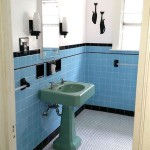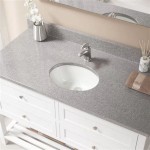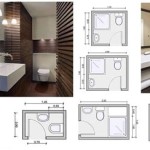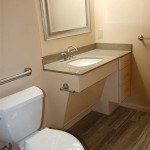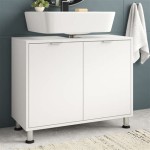How To Make A Bathroom Vanity Out Of A Dresser
Repurposing furniture is a sustainable and cost-effective approach to home improvement. Transforming an old dresser into a bathroom vanity can add character and functionality to a bathroom, offering a unique alternative to standard store-bought vanities. This process involves modifying the dresser to accommodate plumbing, reinforcing its structure for bathroom conditions, and customizing its appearance to match the bathroom's aesthetic.
Before starting the project, careful planning and preparation are crucial. This includes selecting a suitable dresser, gathering the necessary tools and materials, and understanding the existing plumbing layout in the bathroom. A well-defined plan minimizes errors and ensures a smoother renovation process.
Selecting the Right Dresser
The initial step involves selecting a dresser that is appropriate for conversion into a bathroom vanity. The size and style of the dresser should complement the dimensions and design of the bathroom. Consider the height, width, and depth of the dresser to ensure it fits comfortably within the allocated space. A dresser that is too large can crowd the bathroom, while one that is too small might not provide adequate storage.
The dresser's construction and material also play a significant role in its suitability for bathroom use. Solid wood dressers are generally more durable and resistant to moisture than those made of particleboard or MDF. However, all wood types benefit from a protective sealant to prevent water damage and warping. Inspect the dresser for signs of existing damage, such as cracks, rot, or insect infestation. Addressing these issues before starting the conversion is essential for ensuring the longevity of the vanity.
The style of the dresser should align with the overall aesthetic of the bathroom. A vintage dresser can add a touch of charm to a classic bathroom, while a modern dresser can complement a contemporary design. Consider the existing hardware on the dresser, such as knobs and pulls, and whether they need to be replaced to match the desired style. The number and configuration of drawers and cabinets should also be considered, as they will determine the storage capacity of the vanity.
When selecting a dresser, also consider the ease of modification. Dressers with intricate carvings or complex designs may be more challenging to alter to accommodate plumbing. Simpler designs often lend themselves better to customization and adaptation.
Preparing the Dresser for Conversion
Once a suitable dresser has been selected, the next step is to prepare it for conversion into a bathroom vanity. This involves cleaning the dresser thoroughly, removing any existing hardware, and making any necessary structural repairs. The goal is to create a clean, stable base for the subsequent modifications.
Begin by cleaning the dresser with a mild detergent and water. Remove any dust, dirt, or grime that has accumulated on the surface. Pay particular attention to crevices and corners, where dirt may be trapped. Allow the dresser to dry completely before proceeding. Once the dresser is clean and dry, remove all existing hardware, such as knobs, pulls, and drawer slides. These items can be reused later or replaced with new hardware to update the dresser's appearance.
Inspect the dresser for any structural damage, such as loose joints, cracks, or rot. Repair any damage using wood glue, wood filler, or replacement wood pieces. Reinforce weak joints with screws or nails. If the dresser has any signs of rot or insect infestation, treat it with appropriate wood preservatives before proceeding. Addressing these issues early on will prevent further damage and ensure the longevity of the vanity.
If the dresser has a finished surface, consider sanding it down to create a smooth, even surface for painting or staining. Use progressively finer grits of sandpaper to achieve a smooth finish. Sanding also helps to remove any existing imperfections or scratches. If the dresser has a particularly durable finish, you may need to use a chemical stripper to remove it completely.
Modifying the Dresser for Plumbing
The most critical step in converting a dresser into a bathroom vanity is modifying it to accommodate the plumbing. This involves cutting holes for the sink drain and water supply lines, as well as creating space for the P-trap. Careful planning and precise measurements are essential to ensure that the plumbing fits properly and functions correctly.
Begin by determining the location of the sink drain and water supply lines. Use a measuring tape and pencil to mark the locations on the top and back of the dresser. Consult the specifications for the chosen sink and faucet to determine the exact dimensions and placement of the holes. It is advisable to consult with a plumber to ensure that the plumbing modifications comply with local codes and regulations.
Use a hole saw of the appropriate diameter to drill the holes for the sink drain and water supply lines. Start by drilling a pilot hole to guide the saw and prevent it from wandering. Drill slowly and carefully to avoid splintering the wood. If the dresser has multiple layers of wood, such as a veneer over a solid core, take extra care to avoid damaging the veneer.
Once the holes have been drilled, create space for the P-trap, which is a curved pipe that prevents sewer gases from entering the bathroom. This may involve cutting away part of the back or bottom of the dresser, or modifying the drawers or cabinets. Use a jigsaw or reciprocating saw to make these cuts. Ensure that the cuts are clean and straight, and that there is enough space for the P-trap to fit comfortably without interfering with the drawers or cabinets.
After making the plumbing modifications, seal the cut edges of the wood with a waterproof sealant to prevent water damage. This is particularly important for areas that will be exposed to moisture, such as the inside of the cabinet and around the sink drain. Apply several coats of sealant, allowing each coat to dry completely before applying the next.
Reinforcing the Dresser for Bathroom Conditions
Bathrooms are inherently humid environments, which can be detrimental to wooden furniture. Reinforcing the dresser to withstand these conditions is crucial for ensuring its longevity as a bathroom vanity. This includes applying a waterproof sealant to all surfaces, reinforcing weak joints, and providing adequate ventilation.
Begin by applying a waterproof sealant to all surfaces of the dresser, including the inside and outside. Use a high-quality sealant that is specifically designed for bathroom use. Apply several coats of sealant, allowing each coat to dry completely before applying the next. Pay particular attention to areas that will be exposed to moisture, such as the top of the dresser, the inside of the cabinet, and around the sink drain.
Reinforce any weak joints with screws, nails, or wood glue. Check all the connections between the dresser's components, such as the legs, frame, and drawers, and tighten or reinforce them as needed. This will help to prevent the dresser from becoming wobbly or unstable over time.
Provide adequate ventilation inside the cabinet to prevent moisture buildup. This can be achieved by drilling small holes in the back or sides of the cabinet, or by leaving the cabinet doors slightly ajar. Good ventilation will help to prevent mold and mildew from forming, which can damage the dresser and create unpleasant odors.
Customizing the Dresser's Appearance
Once the structural modifications are complete, the final step is to customize the dresser's appearance to match the bathroom's aesthetic. This involves painting or staining the dresser, replacing the hardware, and adding any decorative touches. This is where you can personalize the vanity and make it a unique focal point in the bathroom.
If you choose to paint the dresser, start by priming the surface with a high-quality primer. This will help the paint adhere better and provide a more durable finish. Apply several coats of paint, allowing each coat to dry completely before applying the next. Choose a paint color that complements the bathroom's existing decor. Consider using a semi-gloss or gloss paint, as these finishes are more resistant to moisture and easier to clean.
If you prefer to stain the dresser, choose a stain color that complements the wood and the bathroom's decor. Apply the stain evenly, following the manufacturer's instructions. Allow the stain to dry completely before applying a clear topcoat. A clear topcoat will protect the stain and provide a durable, water-resistant finish.
Replace the existing hardware with new knobs and pulls that match the desired style. Choose hardware that is made of a durable, rust-resistant material, such as stainless steel or brass. The new hardware can significantly update the dresser's appearance and add a personal touch. Consider adding decorative touches, such as stencils, decals, or trim, to further customize the dresser's appearance. These details can add character and personality to the vanity and make it a unique piece of furniture.

How To Make A Dresser Into Vanity Tutorial An Oregon Cottage

Turn A Vintage Dresser Into Bathroom Vanity

A Pro Renovator S 6 Tips For Turning Dresser Into Bathroom Vanity

How To Convert A Dresser Into Bathroom Vanity The Little By Home
/103058794-9279662b921c41259cb908f3cb19acd9.jpg?strip=all)
How To Turn An Old Dresser Into A Beautiful Bathroom Vanity

Stunning Bathroom Tour Dresser Into Double Vanity

How To Make A Dresser Into Vanity Tutorial An Oregon Cottage

Repurposed Dresser Converted To Bathroom Vanity Reinvented Delaware

Flipping Houses Home Renovation In Silicon Valley

Mid Century Dresser Into Vanity Bright Green Door
